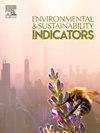Introducing reservoir sustainability indexing to investigate reservoir operations and piloting it at the basin of Lake Urmia with sparse data
IF 5.4
Q1 ENVIRONMENTAL SCIENCES
引用次数: 0
Abstract
Reservoir sustainability indexing/estimation is introduced in this paper, capable of handling sparse data. It innovates by interconnecting a set of three variables: estimating Environmental Water Requirements (EWRs) by conceptual rules; estimating Reliability, Resilience and Vulnerability (RRV) criteria by using EWRs; and thereby calculating Sustainability Indexes (SI), which are either satisfactory or unsatisfactory. These together transform reservoir studies into an innovative capability, implemented by a strategy at three levels: Level 1 scopes critically the research direction setting up a rule engine. Level 2 calculates the EWRs, RRV and SI metrics. Level 3 addresses the defensibility of the results. The capability is piloted on 9 major reservoirs with available data out of 44 in the basin of Lake Urmia for a proof-of-concept. The subsequent knowledge discovery uncovers that: (i) Of 5.3 Billion Cubic Metres (BCM/Annum) lake inflows, 3.1 BCM/annum is required to maintain the lake, but cut off unwarrantedly, instigated the catastrophe. (ii) SI-values verify that the basin is fragile against unwarranted operations; conversely, evidence is given that restoring Lake Urmia is feasible by overhauling reservoir management. (iii) The emerging retrospective explanation is that reservoir operations are the single root cause instigating the catastrophic disappearance of Lake Urmia.
引入水库可持续性指数调查水库运行情况,并在数据稀少的乌尔米耶湖流域进行试点
本文介绍了能够处理稀疏数据的水库可持续性指数/估算。它的创新之处在于将一组三个变量相互联系起来:通过概念规则估算环境用水要求(EWRs);利用 EWRs 估算可靠性、复原性和脆弱性标准(RRV);从而计算出满意或不满意的可持续性指数(SI)。这些措施共同将水库研究转化为一种创新能力,并通过三个层面的战略加以实施:第一层是严格确定研究方向,建立规则引擎。第二级计算 EWR、RRV 和 SI 指标。第 3 层涉及结果的可辩护性。在乌尔米耶湖盆地的 44 个水库中,对 9 个有可用数据的主要水库进行了概念验证。随后的知识发现表明(i) 在 53 亿立方米(BCM/年)的湖水流入量中,有 31 亿立方米(BCM/年)是维持湖泊所必需的,但却被无故切断,从而引发了灾难。(ii) SI 值验证了该流域在无端操作面前是脆弱的;相反,有证据表明,通过彻底改革水库管理,恢复乌尔米耶湖是可行的。(iii) 新出现的回顾性解释是,水库运行是导致乌尔米耶湖灾难性消失的唯一根源。
本文章由计算机程序翻译,如有差异,请以英文原文为准。
求助全文
约1分钟内获得全文
求助全文
来源期刊

Environmental and Sustainability Indicators
Environmental Science-Environmental Science (miscellaneous)
CiteScore
7.80
自引率
2.30%
发文量
49
审稿时长
57 days
 求助内容:
求助内容: 应助结果提醒方式:
应助结果提醒方式:


